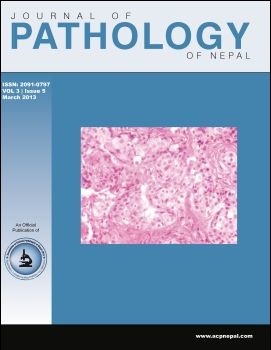Tissue eosinophilia: a morphological marker for assessing stromal invasion in squamous neoplasms of the larynx
DOI:
https://doi.org/10.3126/jpn.v3i5.7861Keywords:
Eosinophilia, Larynx, Squamous neoplasmsAbstract
Background: The assessment of tumour invasion in squamous neoplasms of the larynx poses a diagnostic challenge, especially in small biopsies that are frequently sectioned tangentially. Eosinophilic infi ltration is thought to be an adjunctive criterion in determining tumour invasion. We investigated whether thresholds of eosinophilic infi ltration in laryngeal squamous neoplasms would aid in determining the presence of invasion.
Materials and Methods: Fifty cases of invasive squamous carcinoma, preinvasive squamous neoplasms and benign squamous neoplasms were evaluated. The number of eosinophils per high power field and per 10 high power fields in the stroma adjacent to the neoplastic epithelium were counted and tabulated. For statistical purposes, the elevated eosinophils were defi ned and categorized as: focally and moderately elevated (5-9/HPF), focally and markedly elevated (>10/HPF), diffusely and moderately elevated (5- 19/10HPF), and diffusely and markedly increased (>20/10/HPF).
Results: Eosinophil counts were elevated focally and/or diffusely more frequently in invasive squamous carcinoma than in noninvasive tumours. The increased eosinophil counts, specifically >10/HPF and >20/10HPF, were statistically significantly associated with stromal invasion. Greater than 10/HPF and >20/10HPF had sensitivity, specifi city and positive predictive values of 23%,100%, 100% and 11%,100% and 100% respectively. Cytology was able to diagnose 33 out of 36 malignant cases. Of 17 cases which were diagnosed as benign on cytology, 3 cases turned out to be malignant on biopsy. The sensitivity and specifi city of touch smear cytology are 91.6% and 100% respectively.
Conclusion: The elevated eosinophil count in squamous neoplasms of larynx is a morphologic feature associated with presence of tumour invasion. When the number of infiltrating eosinophils exceeds 10/ HPF and or >20/10HPF in a laryngeal biopsy with squamous neoplasm, it represents an indicator for the possibility of tumour invasion. Similarly, the presence of eosinophils meeting these thresholds in an excisional specimen should prompt a thorough evaluation for invasiveness, when evidence of invasion is absent or is suspected by conventional criteria in the initial sections.
Journal of Pathology of Nepal (2013) Vol. 3, No.1, Issue 5, 374-378
Downloads
Downloads
Published
How to Cite
Issue
Section
License
This license enables reusers to distribute, remix, adapt, and build upon the material in any medium or format, so long as attribution is given to the creator. The license allows for commercial use.




